//The Relative Risk Scale: what is it and why is it important?
Posted 13/05/2022 10:59am
We’ve developed our new relative risk scale to visually represent what the science currently says about the potential risks between the various nicotine product categories. Head of Harm Reduction and Engagement Grant O’Connell explains more.
Given the wide range of nicotine-containing products now available, we believe it’s important policy makers, media, regulators and – most importantly – adult smoker consumers themselves accurately understand how they compare with one another in terms of their risk profiles relative to combustible tobacco.
For instance, this study found 91% of former adult smokers who moved away from combustible cigarettes using an NGP believed accurate information about the products helped them make the transition. Of the 30,000 participants questioned, 72% also believed governments and the tobacco industry should ensure adult smokers have accurate information about potentially less harmful smoking alternatives.
We agree. As our CEO, Stefan Bomhard, explained to the Global Tobacco and Nicotine Forum, the tobacco industry: “will only continue to make progress if smokers are appreciated as active citizens, informed consumers and diverse individuals.”
To make a meaningful contribution to tobacco harm reduction, we have to inform and educate adult smoker consumers about the reality of the risks surrounding smoking-related disease, nicotine and these Next Generation Products (NGPs) which offer a potentially harm reduced alternative to combustible tobacco.
The relative risk scale is a great way of helping achieve this.
While the concept of different nicotine products existing on a scale of risk isn’t new to our business, the wider tobacco industry or public health, we believe this latest iteration is the simplest and most consumer-friendly so far.

Understanding the relative risk scale
To understand the relative risk scale and where individual product categories ‘sit’ on it, we need to initially consider what causes risk in nicotine-containing products. Simply, the order and position of products on the relative risk scale is primarily determined by one critical factor:
TOBACCO COMBUSTION VS NGPS’ ABSENCE OF COMBUSTION

This is by far the most important element differentiating all products on the relative risk scale.
Burning tobacco produces smoke containing over 7000 chemicals, around 100 of which are classified by public health experts as causes or potential causes of smoking-related diseases. Since smoking requires the generation of harmful smoke to release nicotine, combustible cigarettes contain by far the highest level of toxicants and present the highest risk of adult smokers developing some kind of smoking-related disease.
NGPs, on the other hand, don’t burn tobacco. They are therefore collectively grouped closer to medically licensed Nicotine Replacement Therapies (NRTs) on the scale, as they possess similar potential harm reduction profiles to one another.
Besides combustion, there are two other factors which also inform products’ positions on the scale.
TOBACCO-CONTAINING VS TOBACCO-FREE
 While some NGPs contain tobacco, others contain only nicotine. For high quality, tobacco-free NGPs (like our vape e-liquids and tobacco-free oral nicotine pouches), nicotine is extracted from the tobacco leaf, purified to 99.9% pharmaceutical grade standards, and added to products. Tobacco, in its unburnt form, naturally contains some toxicants, although importantly at much lower levels than those found in tobacco smoke. As such, products which contain tobacco carry more risk than those that don’t. Tobacco-free NGPs therefore sit slightly further to the right on the scale.
While some NGPs contain tobacco, others contain only nicotine. For high quality, tobacco-free NGPs (like our vape e-liquids and tobacco-free oral nicotine pouches), nicotine is extracted from the tobacco leaf, purified to 99.9% pharmaceutical grade standards, and added to products. Tobacco, in its unburnt form, naturally contains some toxicants, although importantly at much lower levels than those found in tobacco smoke. As such, products which contain tobacco carry more risk than those that don’t. Tobacco-free NGPs therefore sit slightly further to the right on the scale.
METHOD OF NICOTINE DELIVERY
 Human lungs contain a network of delicate structures called alveoli, used to exchange air. Alveoli are sensitive to injury from external environmental exposures, meaning any material (other than air) is likely to cause some biological effects. If an NGP delivers nicotine via inhalation, while this will increase the speed of nicotine delivery – similar to a combustible cigarette – it also incurs more risk than a product that’s used orally or dermally.
Human lungs contain a network of delicate structures called alveoli, used to exchange air. Alveoli are sensitive to injury from external environmental exposures, meaning any material (other than air) is likely to cause some biological effects. If an NGP delivers nicotine via inhalation, while this will increase the speed of nicotine delivery – similar to a combustible cigarette – it also incurs more risk than a product that’s used orally or dermally.
Products and their positions
Alongside the relative risk scale itself, the below rationale also further explains products’ positions on the scale, and the criteria informing said positions (left = highest risk, right = lowest risk):
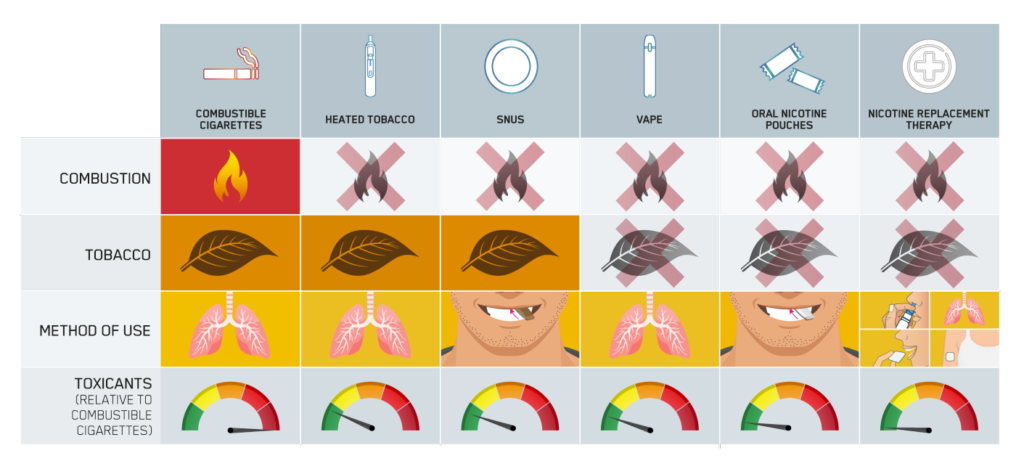
 Combustible cigarettes sit at the far left of the relative risk scale. Decades of scientific evidence clearly demonstrate that combusting (burning) tobacco and inhaling the smoke – which, as well as nicotine, also contains numerous toxicants at high levels – is the primary cause of smoking related illness, including lung cancer, emphysema and heart disease. Cigarettes present by far the highest risk profile, with all other nicotine-containing products being ranked relative to them.
Combustible cigarettes sit at the far left of the relative risk scale. Decades of scientific evidence clearly demonstrate that combusting (burning) tobacco and inhaling the smoke – which, as well as nicotine, also contains numerous toxicants at high levels – is the primary cause of smoking related illness, including lung cancer, emphysema and heart disease. Cigarettes present by far the highest risk profile, with all other nicotine-containing products being ranked relative to them.
Next Generation Products
As mentioned above, NGPs don’t burn tobacco – the most critical element in determining a product’s position. This means there’s a substantial reduction in the potential smoking-related disease risk between combustible cigarettes and all NGPs.
Despite having their own distinct potential harm reduction profiles, NGPs are therefore collectively grouped closer to medically licensed NRTs on the scale.
 Heated tobacco (HT) devices heat without burning the tobacco contained in their consumables, producing an inhalable aerosol. This aerosol contains the nicotine and flavours adult smokers desire, alongside far fewer and lower levels of the harmful chemicals in combustible cigarette smoke. HT consumables are partly made up of tobacco, which naturally contains some toxicants. HT aerosol is also inhaled, meaning nicotine is absorbed quickly (similar to the speed of a combustible cigarette). That said, this route of delivery involves some lung-associated risks.
Heated tobacco (HT) devices heat without burning the tobacco contained in their consumables, producing an inhalable aerosol. This aerosol contains the nicotine and flavours adult smokers desire, alongside far fewer and lower levels of the harmful chemicals in combustible cigarette smoke. HT consumables are partly made up of tobacco, which naturally contains some toxicants. HT aerosol is also inhaled, meaning nicotine is absorbed quickly (similar to the speed of a combustible cigarette). That said, this route of delivery involves some lung-associated risks.
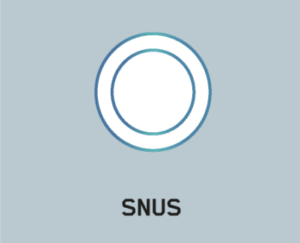 Used for centuries in Scandinavia, snus isn’t always considered an NGP. However, it’s an important part of the THR story with years of epidemiological research demonstrating its harm-reduced compared to combustible cigarettes. It’s an oral smokeless tobacco product so naturally doesn’t require the burning of tobacco to release nicotine. Like heated tobacco it does contain tobacco leaf, which contains some toxicants so incurs some risk. Snus delivers nicotine from the tobacco via orally via the gum membranes, meaning lung-related toxicity and disease risks are not to be expected. That said, this method of nicotine delivery is slower than inhalation, meaning it limits the nicotine satisfaction it can provide to adult smokers.
Used for centuries in Scandinavia, snus isn’t always considered an NGP. However, it’s an important part of the THR story with years of epidemiological research demonstrating its harm-reduced compared to combustible cigarettes. It’s an oral smokeless tobacco product so naturally doesn’t require the burning of tobacco to release nicotine. Like heated tobacco it does contain tobacco leaf, which contains some toxicants so incurs some risk. Snus delivers nicotine from the tobacco via orally via the gum membranes, meaning lung-related toxicity and disease risks are not to be expected. That said, this method of nicotine delivery is slower than inhalation, meaning it limits the nicotine satisfaction it can provide to adult smokers.
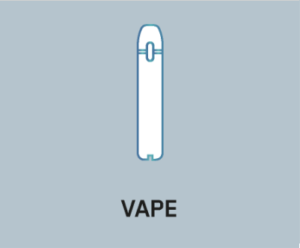 Vapes don’t burn tobacco to release nicotine; in fact they don’t contain any tobacco leaf at all. High quality vapes use e-liquids containing tobacco-derived, pharmaceutical grade nicotine (the same as in NRTs), propylene glycol and vegetable glycerol alongside various flavourings. Vape products are tobacco-free, so they contain lower levels of the toxicants found naturally in the tobacco plant. Like heated tobacco, vapes deliver nicotine via inhalation. This means the speed of nicotine delivery is closer to a combustible cigarette than other tobacco-free products like NRTs. However, as previously mentioned, inhalation involves some lung-associated risks.
Vapes don’t burn tobacco to release nicotine; in fact they don’t contain any tobacco leaf at all. High quality vapes use e-liquids containing tobacco-derived, pharmaceutical grade nicotine (the same as in NRTs), propylene glycol and vegetable glycerol alongside various flavourings. Vape products are tobacco-free, so they contain lower levels of the toxicants found naturally in the tobacco plant. Like heated tobacco, vapes deliver nicotine via inhalation. This means the speed of nicotine delivery is closer to a combustible cigarette than other tobacco-free products like NRTs. However, as previously mentioned, inhalation involves some lung-associated risks.
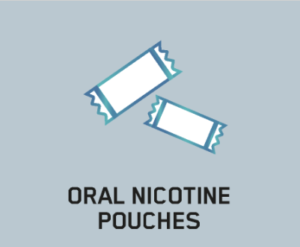 Like vapes, tobacco-free oral nicotine pouches use the same pharmaceutical nicotine as NRTs which is either combined with a plant fibre-based substrate (e.g. wheat or bamboo) or in a dry powder format. As their name suggests, they don’t contain or burn tobacco and are instead used orally, delivering nicotine via the gum membranes. Subsequently, they contain far fewer and lower levels of harmful chemicals compared to cigarette smoke. Based on the three relative risk criteria outlined (non-combustion, non-tobacco and no-inhalation), oral nicotine pouches sit closest to NRTs on the scale.
Like vapes, tobacco-free oral nicotine pouches use the same pharmaceutical nicotine as NRTs which is either combined with a plant fibre-based substrate (e.g. wheat or bamboo) or in a dry powder format. As their name suggests, they don’t contain or burn tobacco and are instead used orally, delivering nicotine via the gum membranes. Subsequently, they contain far fewer and lower levels of harmful chemicals compared to cigarette smoke. Based on the three relative risk criteria outlined (non-combustion, non-tobacco and no-inhalation), oral nicotine pouches sit closest to NRTs on the scale.
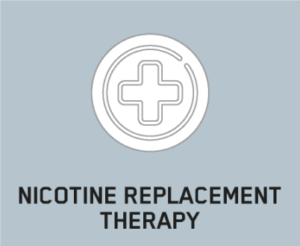 NRTs sit at the far right of the relative risk scale. As they don’t contain or burn tobacco, and mostly don’t require inhalation, they contain dramatically fewer and lower levels of harmful toxicants in combustible cigarette smoke. Regulated as medicines, they are established as dramatically less harmful than combustible cigarettes – although disappointing transition rates suggest they have not always proven popular among adult smokers.
NRTs sit at the far right of the relative risk scale. As they don’t contain or burn tobacco, and mostly don’t require inhalation, they contain dramatically fewer and lower levels of harmful toxicants in combustible cigarette smoke. Regulated as medicines, they are established as dramatically less harmful than combustible cigarettes – although disappointing transition rates suggest they have not always proven popular among adult smokers.
It’s important to note that the relative risk scale is illustrative and based on the current scientific evidence. However, its key message is clear: products which don’t burn tobacco to release nicotine are likely to be much less harmful than combustible cigarettes.
In other words, there’s a significant gap in terms of the risk profile of combustible tobacco compared to the NGP that sits ‘nearest’ to it on the scale (heated tobacco). This is a crucial takeaway for regulators, the media and – most importantly – adult smoker consumers alike.
Future State
When considered within the broader context of the harm reduction equation, the dramatic THR potential of NGPs is clearly evident.
The relative risk scale and rationale provide simple and understandable tools to explain the current scientific evidence surrounding nicotine products, as well as the relative risks associated with a range of non-combustible nicotine-containing products compared to combustible tobacco.
Assisted by suitable regulatory frameworks that advocate their adoption, they have the potential to help correct the many enduring misconceptions about combustible tobacco and nicotine and make a meaningful contribution to tobacco harm reduction for the world’s one billion-plus adult smokers.
To further explore our new relative risk scale, please click here.
